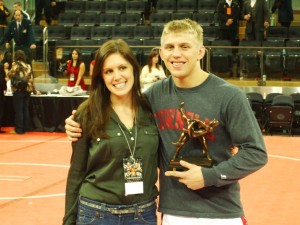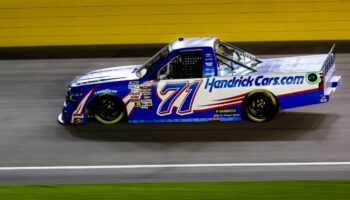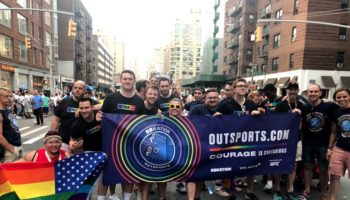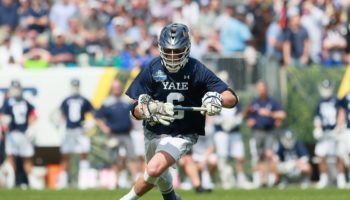New York– The American equivalent of an ancient Greek amphitheater, Madison Square Garden hosted another show of athletic prowess on Sunday that has become its wont for over a century. Current greats took their place on stage, past legends seated in attendance to take it in, rabid fans cheering on their heroes – or curse their enemies.
The script was all the same inside the hallowed halls, but for the first time ever below the flat roof of the World’s Most Famous Arena, the tragedy/comedy unfolding was not on a stage made of hardwood, a sheet of ice, carpet or even canvas.
College wrestling, its roots steeped in equal parts past ancient Greek Olympiads and mythology, made its MSG debut during Grapple at the Garden, an exhibition showcasing some of the nation’s best collegiate wrestlers and 14 colleges competing in two dual meets, including No. 2 Oklahoma State, No. 4 Iowa, No.7 Missouri and eight-ranked Cornell. The sport of college/freestyle wrestling has continued to grow and spread nationwide, in part because of recent greats Cael Sanderson, the current Penn State coach who went undefeated in his Iowa State career and won an Olympic gold, and Anthony Robles, the 2011 NCAA Champion at 125 pounds who was born with only one leg.
On hand at today’s event, outside of the great current athletes, were some of the greats to ever put on a singlet, including former Iowa head coach and Olympic gold medalist Dan Gable, 1984 Olympic gold medalist Kenny Monday, and the most recent American gold medalist from London, Jordan Burroughs.
To be able to have a foothold – or waist hold – in New York City to showcase the nation’s best in a sport with all the attributes that make many of the mainstream sports in America as popular as they are might be the biggest stride taken to increase its “fringe sport” presence.
“It’s Madison Square Garden, not else much needs to be said,” Oklahoma State head coach and two-time Olympic gold medalist John Smith said. “It’s an opportunity to compete as a college wrestler in an arena that has a lot of history.”
It also was a chance for fans to see one particular wrestler on his way to possibly making history. Taking his place among greats to have performed at MSG (including Jordan, Messier, the 1970 New York Knicks, Billy Joel, et al.), Cornell’s Kyle Dake took to the mat today as the tournament’s main attraction – a three-time NCAA champion in three different weight classes and trying to become the first man ever to win national titles in four different weight classes. The top-ranked wrestler at 165 pounds, Dake took on, and defeated, two wrestlers ranked in the top 15 in his class, including No. 3 Tyler Caldwell of Oklahoma State in the most anticipated match of the day. 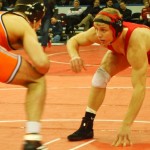 Dake, who defeated Caldwell two years ago to win the national championship at 149 pounds, was able to get on the board after a scoreless first period with a reversal to begin the second period from the down position. An illegal hold from Caldwell earned Dake an extra point, and the cagey affair ended 4-1 in favor of the prohibitive pound-for-pound best wrestler in America. Dake earned the Bill Farrell Award for the best college wrestler at the event (the late Bill Farrell coached the famous 1972 U.S. freestyle wrestling team, which included Gable).
Dake, who defeated Caldwell two years ago to win the national championship at 149 pounds, was able to get on the board after a scoreless first period with a reversal to begin the second period from the down position. An illegal hold from Caldwell earned Dake an extra point, and the cagey affair ended 4-1 in favor of the prohibitive pound-for-pound best wrestler in America. Dake earned the Bill Farrell Award for the best college wrestler at the event (the late Bill Farrell coached the famous 1972 U.S. freestyle wrestling team, which included Gable).
That match, however, also proved to be part of what most hinders the sport and its long-term popularity — from the low-scoring nature of many of the matches, to the actual nuances of moves and scoring (What’s a reversal? A NEAR fall scores points?). The lay sports fans, outside of the quadrennial interest and American jingoism during the summer Olympiad, probably needs more action that you would see at a Duke basketball game to rally around wrestling. Nothing like famous, err, infamous fans and players hustling and crashing into the stands or a scorer’s table to ratchet up the excitement and interest…
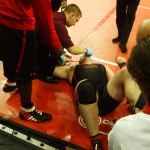
Cue Carl Buchholz and Robin Ficker.
Buchholz, the heavyweight for the No. 18 Maryland, saved the team victory for the Terrapins in the final match of the second dual meet against No. 14 Nebraska with an overtime victory, not only overcoming a two-point deficit in the match against Donny Longendyke to earn the team an 18-17 triumph, but quickly recovering after crashing hard into a press row table and lying on the ground in pain for about a minute. In wrestling, only one injury timeout is granted (length is usually 90 seconds), and afterwards, if the wrestler can’t compete, the match is terminated. Buchholz, a little dazed and with a cotton swab inserted in his left nostril to stop the bleeding, returned to the match and freed himself midway through the second half of the first tiebreaker and held off Longendyke for the individual and team win.
Buchholz and the rest of the Terps team was rooted on vociferously by Robin Ficker, arguably the most well-known sports heckler during his years as a Washington Bullets season-ticket holder and wearing out opponents with his incessant taunts from behind the visitors’ bench. The videos of him berating NBA greats from Michael Jordan to Charles Barkley have become almost NBA folklore. The Bullets/Wizards organization decided to move Ficker’s seat well away from the visitors’ bench when moving into their new arena in 1997, but he instead forsook the club he so loved – or the visiting teams he so hated – and decided to follow the Maryland wrestling team instead, starting in 2010. His fluorescent outfit resembling a walking lava lamp stood out in the lower bowl at Madison Square Garden, as well as some of his chants towards the Nebraska wrestlers.
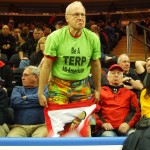
“HE’S FULL OF COOOORRRRNN,” bellowed Ficker during one of the matches, with the go-to line, “RIDE THAT PONY” on call at almost anytime a Maryland opponent was down during the match.
Organizers of the event hope that this is not only a showcase of the sport, but a dress rehearsal for what they hope is a return of college wrestling to the arena for a possible NCAA national championship event (which occurs in March). Given the turnout, the interesting story lines and the sport’s chance to expose the event to more urban areas to expand its reach, it seems only a matter of time before a new March Madness invades The World’s Most Famous Arena.
